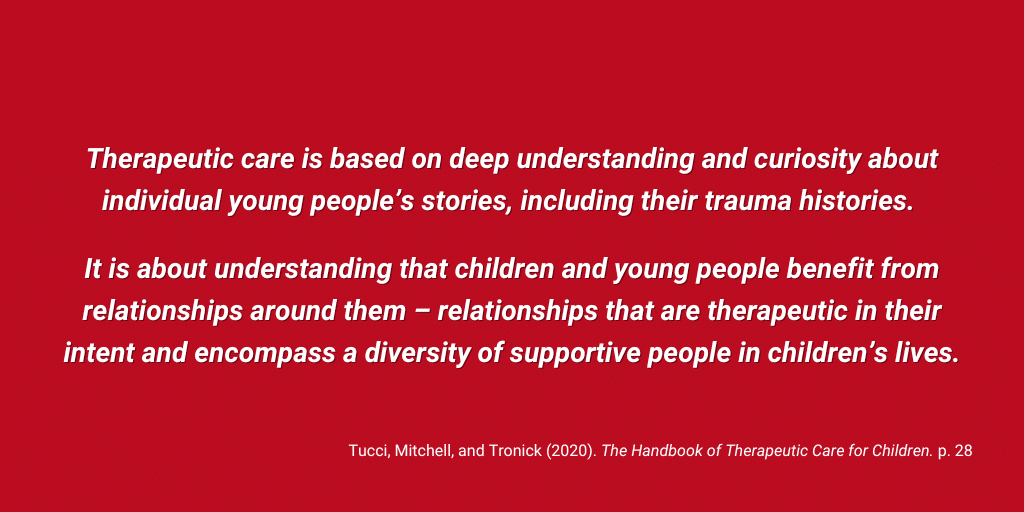And the recommendations are… systemic reform towards providing therapeutic care, again
Jul 2024
Written by Dan Howell
The Australian Institute of Family Studies recently released a report titled Improving the Safety and Wellbeing of Vulnerable Children: A Consolidation of Systemic Recommendations and Evidence. This report aims to bring a national focus on reforms to child protection and youth justice, summarising recommendations from 61 reports and inquiries between 2010 and 2022.
The report highlights consistent themes that have emerged over the years to inform effective support systems, and the common thread within these themes was the importance of holistic therapeutic care for children and young people.

The need for holistic therapeutic care across all care settings
The systems of care and protection for children and young people need significant reform and investment. With varying state-based responsibilities and political priorities, successful strategies in one are rarely adopted in others, leading to repetitive inquiries and new, untested reforms.
The Centre for Excellence in Therapeutic Care has long advocated for therapeutic care to be at the heart of all care placements, including kinship, foster, residential, and custodial care settings. In the report, over 50% of recommendations focus on supporting children already in the system, emphasising the need for therapeutic and holistic care approaches.
A wealth of evidence has long established links between childhood trauma and contact with the youth justice system, as well as trauma’s significant impact on young people’s development, leading to behaviours that challenge resulting from past adaptive strategies.
What is holistic therapeutic care?
Children and young people in custodial settings often have similar traumatic experiences to those in out-of-home care, and similarly need holistic therapeutic care approaches. Developing such a care approach requires a huge perspective shift in how we view “intervention”, away from punitive reactive approaches, towards a supportive culture of rehabilitation and healing.
Tucci, Mitchell, and Tronick (2020, p. 28) describe therapeutic care as a deep understanding of children’s stories and supportive relationships:

They go on to cite Mitchell, Tucci, and Macnamara’s key elements of therapeutic care for children and young people:
- Therapeutic care recognises that trauma related to abuse and violence has a differential impact on each child and young person, leading to a unique configuration of impact and downstream consequences;
- Therapeutic care practice privileges children’s needs as the basis of all of its decisions;
- Therapeutic care understands that children’s behaviour communicates the efforts made by their internal systems to protect them from the traumatic experiences of violation;
- Therapeutic care adopts a lifespan approach to planning for children and young people as they grow and change;
- Therapeutic care honours the strengths of cultural heritage as resources for children and their relationship networks;
- Therapeutic care adopts the view that children’s experiences of deep visceral safety is both an outcome and a form of intervention;
- Therapeutic care is active in ensuring that children and young people who have experienced abuse and neglect are not further disempowered by the way practice is implemented;
- Therapeutic care fosters the authentic participation of children and young people in decision-making processes that are about them;
- Therapeutic care empowers relationships to be therapeutic;
- Therapeutic care conceptualises the physical and sensory environments that children inhabit as therapeutic;
- Therapeutic care expands the role of therapists to become relational brokers, network enablers and system advocates for children in out-of-home care;
- Therapeutic care is resourced by coordinated collective decision-making that serves the needs and interests of children.
Enabling carers and care professionals to be part of the solution
In acknowledging this urgent need for reform, the report highlights the need to train workers in relational and strengths-based practice, to adopt and apply the perspective shift needed of holistic therapeutic care.
The CETC has worked hard to develop a tailored Certificate IV in Youth Justice (CHC40521) that has received overwhelmingly positive feedback. This training uses storytelling and reflective practice to help youth justice workers focus on understanding how trauma shapes the needs of young people, to build their capacity to respond with holistic and therapeutic care.

You can read the full AIFS report available for download.
To join the conversation on current advances to systemic change, register for our upcoming panel discussion on enhancing trauma-informed care in youth detention.
For further details on our accredited training offerings, click here.
References
Mitchell, J., Tucci, J., & Macnamara, N. (2020). What are the key elements of therapeutic care? In J. Mitchell, J. Tucci & E. Tronick (Eds.), The Handbook of Therapeutic Care for Children: Evidence-Informed Approaches to Working with Traumatized Children and Adolescents in Foster, Kinship and Adoptive Care (pp. 35-57). Jessica Kingsley Publishers.

